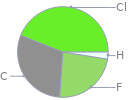Input interpretation

1-chloro-1-fluoroethylene | elemental composition
Result

Find the elemental composition for 1-chloro-1-fluoroethylene in terms of the atom and mass percents: atom percent = N_i/N_atoms × 100% mass percent = (N_im_i)/m × 100% Plan: • Write the chemical formula and gather atomic masses from the periodic table. • Determine values for N_i, m_i, N_atoms and m using these items. • Finally, compute the percents and check the results. Write the chemical formula: CFCl=CH_2 Use the chemical formula to count the number of atoms, N_i, for each element and find the total number of atoms, N_atoms, per molecule: | number of atoms C (carbon) | 2 Cl (chlorine) | 1 F (fluorine) | 1 H (hydrogen) | 2 N_atoms = 2 + 1 + 1 + 2 = 6 Divide each N_i by N_atoms to calculate atom fractions. Then use the property that atom fractions must sum to one to check the work: | number of atoms | atom fraction C (carbon) | 2 | 2/6 Cl (chlorine) | 1 | 1/6 F (fluorine) | 1 | 1/6 H (hydrogen) | 2 | 2/6 Check: 2/6 + 1/6 + 1/6 + 2/6 = 1 Compute atom percents using the atom fractions: | number of atoms | atom percent C (carbon) | 2 | 2/6 × 100% = 33.3% Cl (chlorine) | 1 | 1/6 × 100% = 16.7% F (fluorine) | 1 | 1/6 × 100% = 16.7% H (hydrogen) | 2 | 2/6 × 100% = 33.3% Look up the atomic mass, m_i, in unified atomic mass units, u, for each element in the periodic table: | number of atoms | atom percent | atomic mass/u C (carbon) | 2 | 33.3% | 12.011 Cl (chlorine) | 1 | 16.7% | 35.45 F (fluorine) | 1 | 16.7% | 18.998403163 H (hydrogen) | 2 | 33.3% | 1.008 Multiply N_i by m_i to compute the mass for each element. Then sum those values to compute the molecular mass, m: | number of atoms | atom percent | atomic mass/u | mass/u C (carbon) | 2 | 33.3% | 12.011 | 2 × 12.011 = 24.022 Cl (chlorine) | 1 | 16.7% | 35.45 | 1 × 35.45 = 35.45 F (fluorine) | 1 | 16.7% | 18.998403163 | 1 × 18.998403163 = 18.998403163 H (hydrogen) | 2 | 33.3% | 1.008 | 2 × 1.008 = 2.016 m = 24.022 u + 35.45 u + 18.998403163 u + 2.016 u = 80.486403163 u Divide the mass for each element by m to calculate mass fractions. Then use the property that mass fractions must sum to one to check the work: | number of atoms | atom percent | mass fraction C (carbon) | 2 | 33.3% | 24.022/80.486403163 Cl (chlorine) | 1 | 16.7% | 35.45/80.486403163 F (fluorine) | 1 | 16.7% | 18.998403163/80.486403163 H (hydrogen) | 2 | 33.3% | 2.016/80.486403163 Check: 24.022/80.486403163 + 35.45/80.486403163 + 18.998403163/80.486403163 + 2.016/80.486403163 = 1 Compute mass percents using the mass fractions: Answer: | | | number of atoms | atom percent | mass percent C (carbon) | 2 | 33.3% | 24.022/80.486403163 × 100% = 29.85% Cl (chlorine) | 1 | 16.7% | 35.45/80.486403163 × 100% = 44.04% F (fluorine) | 1 | 16.7% | 18.998403163/80.486403163 × 100% = 23.60% H (hydrogen) | 2 | 33.3% | 2.016/80.486403163 × 100% = 2.505%
Mass fraction pie chart

Mass fraction pie chart